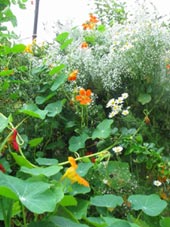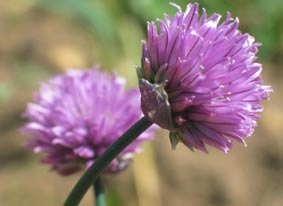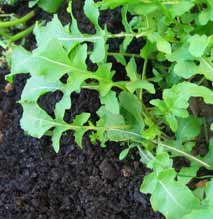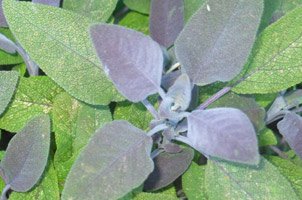Salad Ingredients for Zappier Lunches
The Best Salad Ingredients for a Green Kitchen
Salads can be pretty boring.

Most salads start with lettuce and it is, of course, one of the best ingredients.
Cucumber, tomatoes and a little spring onion and maybe a little pickled beetroot and coleslaw complete the picture.
But more exciting salads are really quite easy.
Here are some ideas for salad ingredients to put a zing into your homemade salads. Most of the herbs and salad plants can be grown at home as part of an organic garden.
Picture: Nasturtium leaves and flowers - plentiful and peppery
First, more on lettuce:
Lovely lettuce!
Lettuce is deservedly one of the most popular of salad ingredients. There are dozens of good varieties with very different tastes and textures. There is often more choice in supermarkets these days but it can be hard to find interesting varieties which have been grown organically.
Some commercial lettuce are sprayed against bugs dozens of times. Organic growers are able to avoid bugs in the main by careful husbandry techniques. They sometimes use introduced species which eliminate aphids (greenfly). And they use careful planting of companion species to help control pests.
If you are growing lettuce at home, you may not be able to avoid the odd bug or slug, although choosing the best pest-resistant lettuce will help, as will using companion plants.
Wash your lettuce thoroughly, separating the leaves. Soak them for a few minutes in salted water. This slays most unwanted creatures. (You can do this with practically any salad ingredient.) Don't leave the leaves in the salty water for a long time as the tissues will start to swell and suffer damage.
Here are some other green salad ingredients to complement lettuce.
Basil - an obvious one to start
Basil is one of the most fantastic of salad ingredients. The tenderest leaves have a delicate but powerful flavour and the overall effect is very refreshing. You can make salad with tomatoes and basil and very little else.
You can also add a little torn up basil to a green salad with good effect.
Chives for a hint of onion flavour

Chives and other onion family plants such as shallots and spring onions are a great asset in salads. They give the dish a bit of "bite" without overpowering the other salad ingredients.
Chives and garlic chives are often available from the garden in the dead of winter and you can always bring them inside onto a windowsill for easy access.
You can even add chive flowers for a splash of colour!
Dandelion for a pleasantly bitter note
Dandelions are amazingly rich in potassium and can give a contrasting bitter note to a salad mixture. Pick fresh light green leaves from near the centre of the plant in spring or autumn. You don't need to grow them specially, though you can. Most organic gardens will probably have a few growing in out of the way verges and the like.
You can also blanch the leaves a little by covering them with an old plant pot for a few days before picking. As they are chock full of potassium, they are one of the most beneficial of salad ingredients. But watch out for their diuretic effects!
Marigold, herb of the sun
Marigold (Calendula officinalis)
This is such a brilliant plant! Not only does it look wonderful, it flowers practically all the year round (Calendula - meaning calendar) and it supplies a useful herb for cuts and grazes. You can even use it in salad. A few petals scattered across a salad look appealing and have a delicate taste.
Marigold is supposed to be good for the circulatory system and is beneficial for skin too.
Marjoram - joy of the mountain
Marjoram leaves are quite pleasant in salad in small amounts. Chop them fairly finely.
Marjoram has health benefits too, though the "Pot Marjoram" found in garden centres is not so potent. Marjoram vulgare is a digestive, that is it aids digestion and helps the body to detoxify itself.
You can also use the flowers if you like.
Marjoram means 'joy of the mountain' which is a reflection of it's beautiful aromatic scent. It is one of the easiest of salad ingredients to grow if you live anywhere warmish. Once it is established it slowly takes over the garden.
The Spanish are fond of using it sprinkled onto a green salad.
Mint for mental refeshment
A scattering of mint can be very refreshing in a leaf salad. Chop it up a bit to prevent you getting an overwhelming mouthful! The flowers also look quite pretty in salads.
Mint also has digestive properties and can relieve slight nausea. It may also relieve a tendency to headaches, so try it in salads and teas if you are a sufferer.
It also has a reputation for helping against depression and re-invigorating the whole system! For me, it's one of the best salad herbs as it is so cool and refreshing.
Nasturtium for a bit of bite!
Nasturtium leaves add a peppery tang to green salads. And they are available right through to the first severe frosts of winter. You can also use the petals of the flowers for added colour and charm. They taste just as distinctive as the leaves and are juicy too. Just watch out for bugs - a good wash is recommended!
Nasturtium has a reputation for stimulating the appetite, curing tiredness and depression and cleansing the blood. Quite a list for an unassuming garden flower!
You can also use the seeds in pickling mix.
Parsley for digestion and fresh breath
Parsley is good in salad. The flat leaved Italian parsley is one of the best types. Curly leafed parsley may be a bit overwhelming in green salads but it makes a good garnish for egg and tuna salads.
Parsley has a role in keeping the urinary system in good shape. It is also mildly aperient, so it is good for your health but don't overdo it.
Chewing a leaf or two of parsley is also supposed to help bad breath, reducing the effects of other more potent herbs and foods. Try chewing some after eating garlic to minimise the anti-social effects!
Parsley is easy to grow at home and will self-seed happily if you let it. It can be a bit slow to germinate. It's another herb which does quite well in pots.
See here for how to grow parsley at home.
Rocket, sage and tarragon - no need to run to the supermarket

Rocket is a tasty addition to a side salad or you can use it as one of the main salad ingredients.
You really don't need to run out to the supermarket for this one! If you've got a small patch of ground, or even a few patio tubs or planters, you can grow rocket. It will grow throughout the season and self-seeds very easily.
The fresh young seedlings give the tenderest harvest but you can also use older leaves and even flowers if you run short of the newer growth.
Picture above: Rocket is very easy to grow and it's perfect for adding to a salad
Sponsored links
Picture below: Sage leaves are strong tasting and antiseptic - but they can still work as salad ingredients, used in moderation

Sage leaves can be chopped up finely with other herbs and used to garnish a salad. A small amount is good, as it can be a bit powerful.
This is another powerful antiseptic herb, famous for helping relieve sore throats and colds. Like thyme and rosemary, it has been in use from ancient times.
Tarragon is mild and pleasant tasting and makes another good ingredient if scattered in with other blander ingredients. It is not so strong that it can compete with the more powerful herbs such as sage and thyme.
If you have a choice, get French Tarragon in preference to Russian. The flavour is finer. This herb dies down in winter and in spring the young shoots take a while to develop a decent amount of taste.
Tarragon is lovely with egg dishes, so try some in an egg salad. It is also a good substitute if you run out of basil for a tomato salad. It is hardier than basil and rather easier to grow, too.
Thyme for taste
Dreadful pun, I know, but it is tasty!
Thyme (Thymus serpyllum and Thymus vulgaris) is an exceptionally powerful antiseptic plant. It has been used in herbal medicine almost forever and in conventional medicine too, providing oil of thymol which is used in antiseptics.
It is used by herbalists as a liver tonic and for a multitude of problems.
In salads it adds a distinctive, cleansing taste.
It is best added in small amounts as it is also quite potent-tasting. For the same reason it's best if chopped reasonably finely. The stalks are best discarded as they are generally rather woody.
Nevertheless, it is well worthwhile addition to salads from time to time. See here for more on how to growing herbs indoors and out
A greener lifestyle - literally!
All these salad ingredients can be part of a green lifestyle; most of them are easy to grow organically.
They can be tucked into odd corners of the garden and many of them can be grown in tubs and planters. Some, such as marigold, have a useful additional life as a companion plant.
Most should be available locally in farmers markets and other organic outlets.
I hope you will enjoy collecting more herbs and flowers to add to your salads. There are benefits to be had in health and taste and you may even cut down a few food miles - a good green living objective.
Of course, you don't have to save these just for lunch. A good green salad goes with practically any meal.

| Tweet |

Footprints
- an occasional e-zine from Greenfootsteps
If you would like to receive the e-zine, please just sign up below.







New! Comments
Have your say about what you just read! Leave me a comment in the box below.